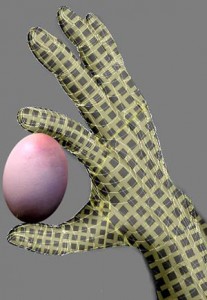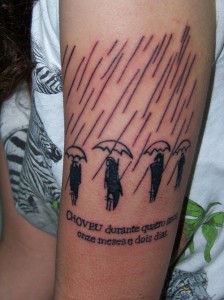We take it for granted most of the time. The ability to sense pressure and respond to appropriately doesn’t seem like any great gift but without it, you’d crush fragile objects or be unable to hold onto the heavy ones.
It’s this ability to sense pressure that’s a stumbling block for robotmakers who want to move robots into jobs that require some dexterity, e.g., one that could clean yours windows and your walls without damaging one or failing to clean the other.
Two research teams have recently published papers about their work on solving the ‘pressure problem’. From the article by Jason Palmer for BBC News,
The materials, which can sense pressure as sensitively and quickly as human skin, have been outlined by two groups reporting in [the journal] Nature Materials.
The skins are arrays of small pressure sensors that convert tiny changes in pressure into electrical signals.
The arrays are built into or under flexible rubber sheets that could be stretched into a variety of shapes.
The materials could be used to sheath artificial limbs or to create robots that can pick up and hold fragile objects. They could also be used to improve tools for minimally-invasive surgery.
One team is located at the University of California, Berkeley and the other at Stanford University. The Berkeley team headed by Ali Javey, associate professor of electrical engineering and computer sciences has named their artificial skin ‘e-skin’. From the article by Dan Nosowitz on the Fast Company website,
Researchers at the University of California at Berkeley, backed by DARPA funding, have come up with a thin prototype material that’s getting science nerds all in a tizzy about the future of robotics.
This material is made from germanium and silicon nanowires grown on a cylinder, then rolled around a sticky polyimide substrate. What does that get you? As CNet says, “The result was a shiny, thin, and flexible electronic material organized into a matrix of transistors, each of which with hundreds of semiconductor nanowires.”
But what takes the material to the next level is the thin layer of pressure-sensitive rubber added to the prototype’s surface, capable of measuring pressures between zero and 15 kilopascals–about the normal range of pressure for a low-intensity human activity, like, say, writing a blog post. Basically, this rubber layer turns the nanowire material into a sort of artificial skin, which is being played up as a miracle material.
As Nosowitz points out, this is a remarkable achievement and it is a first step since skin registers pressure, pain, temperature, wetness, and more. Here’s an illustration of Berkeley’s e-skin (Source: University of California Berkeley, accessed from http://berkeley.edu/news/media/releases/2010/09/12_eskin.shtml Sept. 14, 2010),

An artist’s illustration of an artificial e-skin with nanowire active matrix circuitry covering a hand. The fragile egg illustrates the functionality of the e-skin device for prosthetic and robotic applications.
The Stanford team’s approach has some similarities to the Berkeley’s (from Jason Palmer’s BBC article),
“Javey’s work is a nice demonstration of their capability in making a large array of nanowire TFTs [this film transistor],” said Zhenan Bao of Stanford University, whose group demonstrated the second approach.
The heart of Professor Bao’s devices is micro-structured rubber sheet in the middle of the TFT – effectively re-creating the functionality of the Berkeley group’s skins with less layers.
“Instead of laminating a pressure-sensitive resistor array on top of a nanowire TFT array, we made our transistors to be pressure sensitive,” Professor Bao explained to BBC News.
Here’s a short video about the Stanford team’s work (Source: Stanford University, accessed from http://news.stanford.edu/news/2010/september/sensitive-artificial-skin-091210.html Sept. 14, 2010),
Both approaches to the ‘pressure problem’ have at least one shortcoming. The Berkeley’s team’s e-skin has less sensitivity than Stanford’s while the Stanford team’s artificial skin is less flexible than e-skin as per Palmer’s BBC article. Also, I noticed that the Berkeley team at least is being funded by DARPA ([US Dept. of Defense] Defense Advanced Research Projects Agency) so I’m assuming a fair degree of military interest, which always gives me pause. Nonetheless, bravo to both teams.
